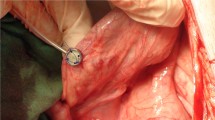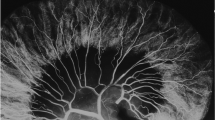Abstract
In order to determine the absolute minimum tissue blood flow (TBF) for safe colonic anastomosis, the wound healing process of anastomotic sites with varying degrees of TBF, measured by laser Doppler velocimetry (LDV), was examined in dogs. Firstly, to clarify how well the LDV value reflects TBF, the correlation between the LDV value and TBF measured by the hydrogen gas clearance method was examined. There was a good correlation between the two methods, with an r value of 0.91. Secondly, after transection and anastomosis of the colon had been performed with varying degrees of devascularization, the anastomotic wound healing process was examined. The LDV values at the anastomotic sites of all dogs in which anastomotic dehiscence had occurred were less than 0.8. In the 2-cm and 4-cm devascularization groups, the mean LDV values were 1.23±0.34 and 0.88±0.20, respectively. There were significant differences between the latter two groups concerning postoperative course, histological features, and hydroxyproline concentration ratio. Thus, as far as TBF is concerned, if the LDV value at the anastomotic site is at least 1.0, corresponding to about 30% of the TBF of the intact colonic wall, the anastomosis is considered to be safe, without risk of dehiscence.
Similar content being viewed by others
References
Goligher JC, Graham NG, De Dombal FT (1970) Anastomotic dehiscence after anterior resection of rectum and sigmoid. Br J Surg 57:109–118
Morgenstern L, Yamakawa T, Ben-Shoshan M, Lippman H (1972) Anastomotic leakage after low colonic anastomosis. Am J Surg 123:104–109
Granger DN, Kvietys PR (1985) Recent advances in measurement of gastrointestinal blood flow. Gastroenterology 88:1073–1076
Larsen KR, Moody FG (1981) Selection of appropriate methodology for the measurement of blood flow in the gut. In: Granger DN, Bulkley GB (eds) Measurement of blood flow. Williams and Wilkins, Baltimore, pp 511–528
Ahn H, Lindhagen J, Nilsson GE, Salerud EG, Jodal M, Lundgren O (1985) Evaluation of laser Doppler flowmetry in the assessment of intestinal blood flow in cat. Gastroenterology 88:951–957
Shigematsu H, Horie Y, Sato M, Miyazawa Y, Mishima Y (1981) Measurement of local blood flow of the intestine by hydrogen clearance method (in Japanese with English abstract) Nippon Shoukakibyo Gakkai Zasshi (Jpn J Gastroenterol) 78:846–855
Gambee LP (1951) A single-layer open intestinal anastomosis applicable to the small as well as the large intestine. West J Surg Obst Gyn 59:1–5
Gambee LP, Garnjobst W, Hardwich CE (1956) Ten years' experience with a single-layer anastomosis in colon surgery. Am J Surg 92:222–227
Cronin K, Jackson DS, Dunphy JE (1968) Changing bursting strength and collagen content of the healing colon. Surg Gyn Obst 126:747–753
Prockop DJ, Udenfriend S (1960) A specific method for the analysis of hydroxyproline in tissues and urine. Anal Biochem 1:228–239
Juva K, Prockop DJ (1966) Modified procedure for the assay of H3-or C14-labeled hydroxyproline. Anal Biochem 15:77–83
Everett WG, Friend PJ, Forty J (1986) Comparison of stapling and hand-suture for left-sided large bowel anastomosis. Br J Surg 73:345–348
Friend PJ, Scott R, Everett WG, Scott IHK (1990) Stapling or suturing for anastomosis of the left side of the large intestine. Surg Gyn Obst 171:373–376
Ohta H, Takahashi T, Kajitani T (1980) On surgical complications after sphincter-preserving operations for rectal cancer (in Japanese). Nippon Shoukaki Geka Gakkai Zasshi (Jpn J Gastroenterol Surg) 13:874–879
Matsumoto K (1982) Experimental studies on prevention of anastomotic dehiscence after low anterior resection of the rectum (in Japanese). Nippon Shoukaki Geka Gakkai Zasshi (Jpn J Gastroenterol Surg) 15:1258–1268
Antonsen HK, Kronborg O (1987) Early complications after low anterior resection for rectal cancer using the EEA stapling device. A prospective trial. Dis Colon Rectum 30:579–583
Irvan TT, Goligher JC (1973) Aetiology of disruption of intestinal anastomosis. Br J Surg 60:461–464
Schrock TR, Deveney CW, Dunphy JE (1973) Factors contributing to leakage of colonic anastomoses. Ann Surg 177:513–518
Cheung LY (1984) Gastric mucosal blood flow: Its measurement and importance in mucosal defense mechanisms. J Surg Research 36:282–288
Chou CC, Grassmick B (1978) Motility and blood flow distribution within the wall of the gastrointestinal tract. Am J Physiol 235:H34-H39
Maeda K (1990) Experimental and clinical study of the colonic ischemic state in the distal colon after left-sided hemicolectomy (in Japanese with English abstract). Nippon Daichokoumonbyo Gakkai Zasshi (J Jpn Soc Colo-Proctol) 43:552–553
Kimura Y (1972) An experimental hemodynamic study on pediculated loop of intestine, and its limit of devascularization (in Japanese). Nippon Geka Gakkai Zasshi (J Jpn Surg Soc) 73:449–459
Amano H (1982) Studies on the relationship between tissue oxygen tension and anastomotic healing of ischemic small intestine in dog and human (in Japanese with English abstract). Nippon Geka Gakkai Zasshi (J Jpn Surg Soc) 83:1398–1410
Maeda K, Kodaira S, Teramoto T, Amano H, Kuromizu J, Umemoto T, Sadahiro S, Takahashi T, Houjyo M, Okuda K, Abe O (1984) Experimental study of colonic blood flow after left-sided hemicolectomy (in Japanese). Saishin Igaku 39:1973–1975
Shikata J, Shida T, Satoh S, Furuya K, Kamiyama A (1982) The effect of local blood flow on the healing of experimental intestinal anastomoses. Surg Gyn Obst 154:657–661
Negishi S, Sawada T, Muto T, Morioka Y (1987) Experimental study on anastomotic dehiscence: The effect of low blood flow and stretched state of anastomosis (in Japanese). Nippon Shoukaki Geka Gakkai Zasshi (Jpn J Gastroenterol Surg) 20:1772–1781
Chung RS, Hitch DC, Armstrong DN (1988) The role of tissue ischemia in the pathogenesis of anastomotic stricture. Surgery 104:824–829
Chung RS (1987) Blood flow in colonic anastomoses. Ann Surg 206:335–339
Gorey TF (1977) Tests of intestinal viability. In: Marston A (ed) Vascular disease of the gut. Edward Arnold, London, pp 52–63
Strandness DE (1978) Doppler ultrasonic techniques in vascular disease. In: Bernstein EF (ed) Noninvasive diagnostic techniques in vascular disease. Mosby, Saint Louis, pp 11–22
Riva C, Ross B, Benedek GB (1972) Laser Doppler measurements of blood flow in capillary tubes and retinal arteries. Invest Ophthalmol Vis Sci 11:936–944
Fujii H, Asakura Y, Ohura T (1985) Blood flow observed by time-varying laser speckle. Opt Lett 10:104–106
Stern MD (1975) In vivo evaluation of microcirculation by coherent light scattering. Nature 254:56–58
Stern MD, Lappe DL, Bowen PD, Chimosky JE, Holloway GA, Keiser HR, Bowman RL (1977) Continuous measurement of tissue blood flow by laser-Doppler spectroscopy. Am J Physiol 232:H441-H448
Watkins D, Holloway GA (1978) An instrument to measure cutaneous blood flow using the Doppler shift of laser light. IEEE Trans Biomed Eng, BME-25:28–33
Nilsson GE, Tenland T, Oberg PA (1980) A new instrument for continuous measurement of tissue blood flow by light beating spectroscopy. IEEE Trans Biomed Eng, BME-27:12–19
Nilsson GE (1984) Signal processor for laser Doppler tissue flowmeters. Med Biol Eng Comput 22:343–348
Fercher AF, Briers JD (1981) Flow visualization by means of single-exposure speckle photography. Opt Commun 37:326–330
Fujii H, Nohira K, Yamamoto Y, Ikawa H, Ohura T (1987) Evaluation of blood flow by laser speckle image sensing. Applied Opt 26:5321–5325
Ono I, Ohura T, Yamamoto A, Murazumi M, Fujii H, Asakura T (1989) Evaluation of the blood flow and the survival length of flaps by using a laser speckle flow meter (in Japanese). Keisei Geka 32:137–145
Shepherd AP, Riedel GL (1982) Continuous measurement of intestinal mucosal blood flow by laser-Doppler velocimetry. Am J Physiol 242:G668-G672
Ahn H, Lindhagen J, Lundgren O (1986) Measurement of colonic blood flow with laser Doppler flowmetry. Scand J Gastroenterol 21:871–88
Saita H, Murakami M, Mizuno M, Yoo JK, Ashida Y, Inoue R, Inada M, Kita T, Miyake T (1989) Evaluation of the laser-Doppler velocimetry method in the measurement of gastric blood flow in rats — spatial resolution (in Japanese with English abstract). Nippon Shoukakibyo Gakkai Zasshi (Jpn J Gastroenterol) 86:1235–1240
Johansson K, Ahn H, Lindhagen J, Lundgren O (1987) Tissue penetration and measuring depth of laser Doppler flowmetry in the gastrointestinal application. Scand J Gastroenterol 22:1081–1088
Adamsons PJ, Enquist IF (1964) The relationship of collagen content to wound strength in normal and scorbutic animals. Surg Gyn Obst 119:323–329
Kitajima M (1974) Experimental studies on wound healing of anastomotic site of gastroduodenostomy with special reference to microangiographic findings (in Japanese). Nippon Geka Gakkai Zasshi (J Jpn Surg Soc) 75:538–553
Jiborn H, Ahonen J, Zederfeldt B (1978) Healing of experimental colonic anastomoses I. Bursting strength of the colon after left colon resection and anastomosis. Am J Surg 136:587–594
Jiborn H, Ahonen J, Zederfeldt B (1978) Healing of experimental colonic anastomoses II. Breaking strength of the colon after left colon resection and anastomosis. Am J Surg 136:595–599
Adamsons RJ, Musco F, Enquist IF (1966) The chemical dimensions of a healing incision. Surg Gyn Obst 123:515–521
Irvin TT (1976) Collagen metabolism in infected colonic anastomoses. Surg Gyn Obst 143:220–224
Hesp FLE, Hendriks T, Lubbers EC, DeBoer HHM (1984) Wound healing in the intestinal wall: Effects of infection on experimental ileal and colonic anastomoses. Dis Colon Rectum 27:462–467
Kvietys PR, Shepherd AP, Granger DN (1985) Laser-Doppler, H clearance, and microsphere estimates of mucosal blood flow. Am J Physiol 249:G221-G227
Author information
Authors and Affiliations
Rights and permissions
About this article
Cite this article
Kashiwagi, H. The lower limit of tissue blood flow for safe colonic anastomosis: An experimental study using laser doppler velocimetry. Surg Today 23, 430–438 (1993). https://doi.org/10.1007/BF00309502
Received:
Accepted:
Issue Date:
DOI: https://doi.org/10.1007/BF00309502




